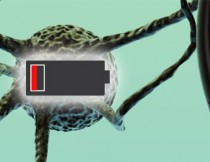Compromised Energy Production in ASD Brain Cells

Read other Conference Update items
by Wayne Pereanu
Cells create all of the energy they need using cellular machines called mitochondria. Because brain cells are one of the largest users of cellular energy (second only to heart cells), several research groups looked to see if the mitochondria were affected in the brains from ASD patients. A small number of studies have since shown that ASD brain cells are less capable of producing cellular energy due to impaired mitochondria.
Guomei Tang presented unpublished research at a poster session on Monday identifying how mitochondria may be impaired in a specific type of brain cell. They looked in an area called the BA21 temporal cortex, which has been shown to look different in ASD patients. Interestingly, the described work showed that these ASD brain cells actually had more mitochondria than the control cells. However, careful investigation showed that the more numerous mitochondria lacked the proper machinery (specifically, electron transport chain complexes components) to actually produce energy efficiently.
This report provides evidence of specifically how mitochondria function may be impaired and demonstrates this in brain cells that are known to look different in brains from ASD patients. Further work is required, but these mitochondrial deficits may eventually be identified as either a biomarker or a significant factor that could be targeted for treatment.

